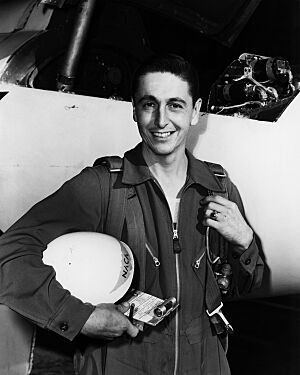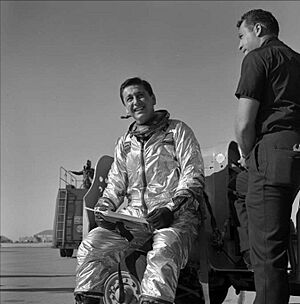Albert Scott Crossfield facts for kids
Quick facts for kids
Albert Scott Crossfield
|
|
|---|---|

Crossfield in 1953
|
|
| Born | October 2, 1921 Berkeley, California, U.S.
|
| Died | April 19, 2006 (aged 84) Ludville, Pickens County, Georgia, U.S.
|
| Resting place | Arlington National Cemetery |
| Education | University of Washington (B.S. 1949, M.S. 1950) |
| Space career | |
| USN-NACA-NAR, Test Pilot, Astronaut-Select |
|
|
Previous occupation
|
Test pilot |
| Selection | 1957 MISS Group |
| Missions | None |
| Retirement | December 6, 1960 |
| Military career | |
| Allegiance | United States |
| Branch | United States Navy |
| Years | c. 1943–46 |
| Rank | Lieutenant |
Albert Scott Crossfield (October 2, 1921 – April 19, 2006) was an American naval officer and a famous test pilot. In 1953, he made history by becoming the first pilot to fly at twice the speed of sound. Crossfield was also the first of twelve pilots to fly the amazing North American X-15, an experimental spaceplane used by the United States Air Force and NASA.
Contents
Early Life and Education
Scott Crossfield was born on October 2, 1921, in Berkeley, California. He grew up in California and Washington state. He went to the University of Washington in Seattle and later worked for Boeing, a big airplane company.
During World War II, he served in the United States Navy. He was a flight instructor and a fighter pilot. He flew many different types of planes, like the F6F Hellcat and F4U Corsair. After the war, from 1946 to 1950, he studied aeronautical engineering at the University of Washington. He earned two degrees in this field.
Flying for NACA
In 1950, Crossfield joined the National Advisory Committee for Aeronautics (NACA). This was a government group that studied flight, and it later became NASA. He worked as a research pilot at Edwards Air Force Base in California.
Crossfield was a very skilled pilot. Once, during a solo flight, he noticed strange noises and shaking while doing a spin. He figured out that the instructor's door was loose and flapping! He closed it, and the problems stopped. This experience made him even more curious about how planes worked.
Over the next five years, he flew many experimental planes. These included the X-1, X-4, and the Douglas D-558-II Skyrocket. On November 20, 1953, he made history in the Skyrocket. He flew it at 1,291 miles per hour (2,078 km/h), which was Mach 2.005. This made him the first person to fly twice the speed of sound!
He flew rocket-powered planes 99 times. This gave him more experience with these types of aircraft than anyone else in the world. In 1955, he left NACA to work for North American Aviation.
Working on the X-15
At North American Aviation, Crossfield became the chief engineering test pilot. He played a huge part in designing and developing the amazing North American X-15 spaceplane. His job was to test how well it flew at incredibly high speeds, up to Mach 3 (2,290 mph).
Testing the X-15 was very dangerous because it was a brand new type of aircraft. Crossfield flew 14 of the 199 total X-15 test flights. He helped design many new features, like putting the engine controls right in the cockpit. Before this, technicians on the ground had to make all the engine adjustments.
On June 8, 1959, he made the X-15's first flight. It was an unpowered glide from high in the sky. The flight was tricky because the controls weren't set up right. He managed to land the plane safely in the desert, even though it was shaking badly.
Later, on his third flight, one of the engines exploded shortly after launch. Crossfield had to make an emergency landing. The plane was damaged, but he was not hurt. He also had a close call during ground tests when another engine exploded. Again, he was lucky and wasn't seriously injured.
On December 6, 1960, he completed his final flight in the X-15. He had hoped to fly the X-15 into space, but the Air Force wanted him to stay within the Earth's atmosphere. He completed 13 powered flights in the X-15.
After his X-15 flights, he continued to work at North American. He helped with quality and testing for important programs like the Apollo spacecraft.
Later Career and Life
In 1967, Crossfield joined Eastern Air Lines. He worked on new technologies for air traffic control, which helps planes fly safely.
From 1977 until he retired in 1993, he worked for the United States House of Representatives Committee on Science and Technology. He was a technical advisor, helping with research and development for civil aviation. He also helped investigate the Space Shuttle Challenger disaster in 1986.
Crossfield often talked about how much computing power was needed to design the X-15. He said that the same calculations could be done on a laptop computer today! He also hinted at private companies working on space travel, like the one that later developed Space Ship One.
In 2004, Crossfield was at the launch of Space Ship One, which was the first private spacecraft to win a major prize for spaceflight. He also helped train pilots to fly a reproduction of the Wright Flyer for the 100th anniversary of the Wright Brothers' first flight.
When asked about his favorite airplane, Crossfield would say, "the one I was flying at the time." He enjoyed all the unique planes he flew.
Death
On April 19, 2006, Scott Crossfield was flying his Cessna 210 plane from Alabama to Virginia. His plane was reported missing during severe thunderstorms. Authorities later found the wreckage of his plane in Pickens County, Georgia.
Investigators found that parts of the plane were spread out, meaning it likely broke apart in the air. The National Transportation Safety Board later said the crash was caused by Crossfield flying into bad weather and air traffic control not giving him enough warning.
Crossfield was buried at Arlington National Cemetery.
Honors and Legacy
Scott Crossfield received many awards for his contributions to aviation. He was honored with the Harmon Trophy and the Collier Trophy by President John F. Kennedy at the White House. He is the only American to be honored at the White House for aviation science more than once.
He was inducted into many halls of fame, including the International Aerospace Hall of Fame (1965) and the National Aviation Hall of Fame (1983). An elementary school in Herndon, Virginia, is named after him.
Crossfield was very proud of the A. Scott Crossfield Aerospace Education Teacher of the Year Award. He created and funded this award to recognize excellent teachers in aerospace education.
Even though he was known as a daring test pilot, Crossfield always said he was an engineer first. He believed that flying helped him design and build better airplanes.
In the future world of Star Trek, a class of starships is named the Crossfield-class in his honor. One of these ships, the USS Discovery, is featured in the TV show Star Trek: Discovery.
|



